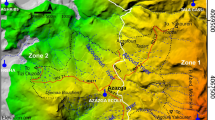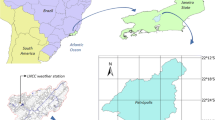Abstract
Landslides triggered by rainfall can be foreseen by modeling the relationship between the time occurrence of landslides and rainfall. This paper deals with the argument by adopting a hydrological model called Forecasting of Landslides Induced by Rainfall (FLaIR). The model is applicable for forecasting recurrent landslides and it is based on the identification of a mobility function Y(.) that links the occurrence of a slope movement to the antecedent rainfall. Once the mobility function is defined, it is possible to define its critical values, the exceeding of which indicates that new mobilizations could occur. The FLaIR model has been used to study some phenomena that happened in Lanzo Valleys, a Western Alps sector of the Piedmont region (Northern Italy) where slope debris flows are the predominant landslide type. The study has led to the development of an early warning system, called MoniFLaIR, for real-time monitoring and forecasting of slope hazard. This article describes some details of the system and its performance.











Similar content being viewed by others
References
Baum RL, Godt JW, Harp EL, McKenna JP, McMullen SR (2005) Early warning of landslides for rail traffic between Seattle and Everett, Washington, U.S.A. In: Proceedings of the International of Conference on Landslide Risk Management, Vancouver, pp 731–740
Bonnard CH, Noverraz F (2001) Influence of climate change on large landslides: assessment of long term movements and trends. In: Proceedings of the International Conference on Landslides causes impact and countermeasures, Gluckauf, Essen, Davos, pp 121–138
Borga M, Dalla Fontana G, Da Ros D, Marchi L (1998) Shallow landslide hazard assessment using a physically based model and digital elevation data. Environ Geol 35(2–3):81–88
Caine N (1980) The rainfall intensity duration control of shallow landslides and debris flows. Geogr Ann 62:23–27
Campbell RH (1975) Debris flow originating from soil slip during rainstorm in southern California. Q J Eng Geol 7:339–349
Cannon SH, Ellen SD (1985) Rainfall conditions for abundant debris avalanches. California Geology, San Francisco Bay Region, p 38
Casadei M, Dietrich WE, Miller NL (2003) Testing a model for predicting the timing and location of shallow landslide initiation in soil mantled landscapes. Earth Surf Processes Landf 28:925–950
Chan RKS, Pang PLR, Pun WK (2003) Recent developments in the landslip warning system in Hong Kong. In: Proceedings of the 14th Southeast Asian Geotechnical Conference
Cole K, Davis GM (2002) Landslide warning and emergency planning systems in West Dorset, England. Instability: planning and management. Thomas Telford, London
Colombo A, Lanteri L, Ramasco M, Troisi C (2005) Systematic GIS-based landslide inventory as the first step for effective landslide-hazard management. Landslides 2(2005):291–301
d’Orsi RN, D’Avila C, Ortigao JAR, Moraes L, Santos MD (1997) Rio-Watch—the Rio de Janeiro landslide watch system. In: Proceedings of the 2nd PSL Pan-Am Symposium on Landslides, Rio de Janeiro, vol. 1, pp 21–30
De Vita P, Reichenbach P (1998) Rainfall-triggered landslides: a reference list. Environ Geol 35:2–3
Glade T, Crozier M, Smith P (2000) Applying probability determination to refine landslide-triggering rainfall thresholds using an empirical “antecedent daily rainfall model”. Pure Appl Geophys 157(6–8):1059–1079
IDNHR Advisory Committee (1987) Confronting natural disaster. An international decade for natural hazard reduction. National Academies, Washington, p 60
Iiritano G, Versace P, Sirangelo B (1998) Real-time estimation of hazard for landslides triggered by rainfall. Environ Geol 35(2–3):175–183
Iverson RM (2000) Landslide triggering by rain infiltration. Water Resour Res 30(7):1897–1910
Keefer DK, Wilson RC, Mark RK, Brabb EE, Brown WM III, Ellen SD, Harp EL, Wieczoreck GF, Alger CS, Zatkin RS (1987) Real-time landslide warning during heavy rainfall. Science 238:921–926
Liu KF, Chen SC (2003) Integrated debris-flows monitoring system and virtual center. In: Proceedings of the III International Conference on Debris-Flow Hazards Mitigation, Mechanics, Prediction and Assessment, Davos, 2, pp 767–774
Lumb P (1975) Slope failure in Hong Kong. Q J Eng Geol 8:31–65
Michiue M (1985) A method for predicting slope failures on cliff and mountain due to heavy rain. J Nat Disaster Sci 7(1):1–12
Miller NL, Kim J (1997) Numerical prediction of precipitation and riverflow over the Russian River watershed during the January 1995 California flooding. Bull Am Meteorol Assoc 77:101–105
Montgomery DR, Dietrich WE (1994) A physically-based model for the topographic control on shallow landsliding. Water Resour Res 30:1153–1171
Pack RT, Tarboton DG, Goodwin CN (1998) The SINMAP approach to terrain stability mapping. In: Proceedings of the 8th Congress of the International Association of Engineering Geology, Vancouver, British Columbia, Canada
Rabuffetti D, Barbero S (2005) Operational hydro-meteorological warning and real-time flood forecasting: the Piemonte region case study. Hydrol Earth Syst Sci 9(4):457–466
Rabuffetti D, Mensio L, Barbero S, Pelosini R, Bovo S (2003) An operating alert procedure for meteo-hydrological risk forecasting and management. In: Proceedings of the Sixth European Conference on Applications of Meteorology, Rome, 15–19 September 2003
Reid ME (1994) A pore-pressure diffusion model for estimating landslide-inducing rainfall. J Geol 102:709–717
Sirangelo B, Versace P (1996) A real time forecasting for landslides triggered by rainfall. Meccanica 31:1–13
Sirangelo B, Versace P, Capparelli G (2003) Forewarning model for landslides triggered by rainfall based on the historical data file. In: Proceedings of International Symposium on Hydrology of the Mediterranean and Semiarid Regions, Montpellier, IAHS, 278
Terzaghi K (1950) Mechanism of landslides. In: Paige S (ed) Application of geology to engineering practice. Geological Society of America, New York
UNDRO (1991) Mitigation natural disaster. Phenomena, effects and options. United Nations, New York, p 164
Versace P, Sirangelo B, Capparelli G (2003) Forewarning model of landslides triggered by rainfall. In: Proceedings of the III International Conference on Debris-Flow Hazards Mitigation, Mechanics, Prediction and Assessment, Davos, 2, pp 1233–1244
Vincente GA, Scofield RA (1998) Satellite rainfall estimates in real time for application to flash flood watches and warnings, heavy precipitation forecasting and assimilation of numerical weather prediction models. In: Proceedings of the 16th Conference on Weather Analysis and Forecasting. American Meteorological Society, Minneapolis, pp 790–793
Wang G, Sassa K (2003) Pore-pressure generation and movement of rainfall-induced landslides: effects of grain size and fine-particle content. Eng Geol 69:109–125
Wilson RC, Wieczorek GF (1995) Rainfall thresholds for the initiation of debris flow at La Honda, California. Environ Eng Geosci 1(1):11–27
Acknowledgements
The authors are gratefully to Prof. Pasquale Versace for his precious support in the development of the FLaIR model applications.
Author information
Authors and Affiliations
Corresponding author
Rights and permissions
About this article
Cite this article
Capparelli, G., Tiranti, D. Application of the MoniFLaIR early warning system for rainfall-induced landslides in Piedmont region (Italy). Landslides 7, 401–410 (2010). https://doi.org/10.1007/s10346-009-0189-9
Received:
Accepted:
Published:
Issue Date:
DOI: https://doi.org/10.1007/s10346-009-0189-9




